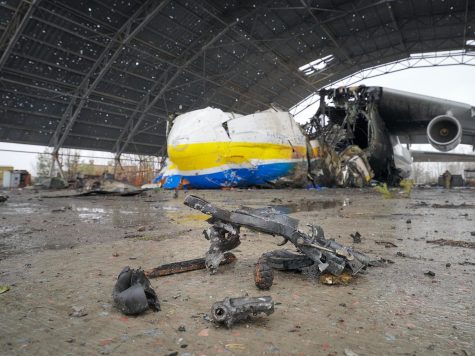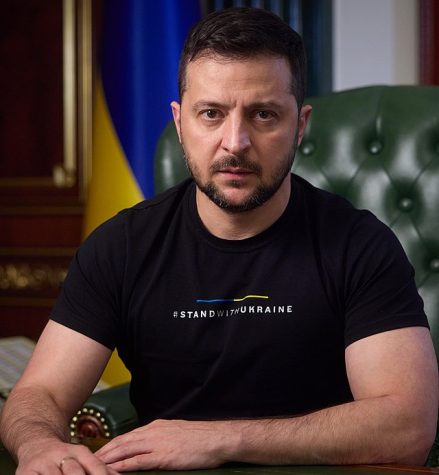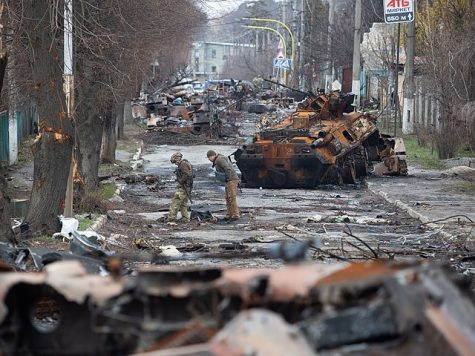Your donation will support the student journalists of Delaware Valley Regional High School. Your contribution will allow us to attend conventions, purchase equipment and cover our annual website hosting costs.
Phase 1
February 24, 2023
Invasion (Feb. 24, 2022)
After remaining camped at the border for months, an estimated 150,000 Russian troops invaded Ukraine from five directions simultaneously.
Shortly after, in the early hours of Feb. 24 (around 5 a.m. Kyiv time), Vladimir Putin made an announcement. In his address, he claimed that his troops’ entrance into Ukraine was merely a “special military operation” and stated that he had no intentions to permanently remain there.
Instead, his rationale behind the invasion was to instead strengthen security for the Russian border, which he believed was under attack due to the expansion of NATO. Putin also imagined that the Ukrainian army would immediately collapse and he would quickly install a puppet regime that would do his bidding, which was reflected by the puzzled Ukrainian defenders finding dress uniforms in the Russian vehicles they managed to disable in the first days of the invasion: part of the Russian plans had included a victory parade through central Kyiv.
The first day of the invasion indeed led to Russia making great progress and soon arrived on the outskirts of Kyiv. By sunset, Russian forces attacking from the north had captured nuclear site Chernobyl after fierce fighting.
Battle of Antonov Airport (Feb. 24-25)
Immediately after entering, Russia had its eyes on Kiev, and in devastating time, the Russians were on the cusp of entering and capturing the capital.

The two sides soon met on an airfield at the cargo airport Antonov, located just 10 kilometers from Kyiv. Control of the airport for either side would be crucial. Defensively, it would aid the Ukrainians in defending their capital.
For the Russians, if they gained control of Antonov, it could serve as a key repository for troops and supplies.
The fighting began when Putin’s troops conducted an air assault over the airport, which was only defended by a handful of defenders. Although the battle first appeared to be heading in the Russians’ favor, the Ukrainians rushed additional reinforcements to the airfield and held back the Russians.
However, the next day, the Russians returned with a second air assault, which was aided by reinforcements from the Belarusian border and successfully captured the airport. Yet, the Ukrainians continued to fight, which led to the airport being eventually abandoned as it became too dilapidated to serve as a suitable base.
The battle of Antonov Airport was, in retrospect, hugely important as it prevented the Russians from gaining an immediate entrance to deploy heavy equipment into Kyiv. If the airport had fallen quickly, the Russians would have swiftly entered Kyiv and targeted the Ukrainian leadership. Fortunately for the Ukrainian cause, that event did not happen all because of the outcome of one outnumbered group of soldiers who bought time for the defense to stabilize.
The push from Crimea into Kherson (Feb. 24-March 2)
On the day of the invasion, Russian troops also entered the Kherson region from Crimea, the territory which Putin had illegally annexed back in 2014. After a few skirmishes the mayor of Kherson, Ihor Kolykhaiev, surrendered the city to the Russians on March 2, making it the first major Ukrainian city to fall to Putin.
The struggle for Kherson brought about heavy Ukrainian casualties, with up to 300 civilians and soldiers being killed. Following its capture, the Russians quickly set up a military administration in the city, with this victory touted as a major Russian success.
The siege of Kharkiv (Feb 24- May 13)
Along with Kyiv, a massive target for the Russian forces was Ukraine’s second most populous city, Kharkiv.
The city, located just 30 kilometers from the Russian-Ukraine border, also has a notable Russian-speaking population.

On Feb. 24, Russian troops made their way to the city, and clashed with Ukrainian defenders on multiple occasions. Fierce fighting shortly broke out in the suburbs surrounding the city, and Putin’s troops soon encircled the city.
Some Russian troops did manage to enter Kharkiv yet were ferociously fought off by Ukrainian troops. A couple of days later, the Russians switched tactics, and opted to resort to targeted air strikes.
Missiles barraged the city for weeks, and according to the city’s mayor, the Russians’ attack led to the destruction of thousands of buildings. Not even residential buildings were spared.
In the midst of the fighting, the Ukrainians led a counter-offensive, and managed to push the Russians away from the city. By mid-May, many Russian forces had been reported to have withdrawn from the area.
Throughout the war, Kharkiv has been one of the hardest hit cities. Over six hundred civilians have lost their lives due to shellings and conflict there.
The ambush/slaughter in Bucha (Feb. 27-March 2022)
Not long after invading Ukraine, Russian forces advanced towards the city of Bucha. The goal was to capture the city and then move on to one of its neighboring cities, Irpin.
Once in range of Bucha, the Russian artillery let loose and destroyed many of the city’s buildings. A portion of its residents were soon stripped of water, electricity and gas.
By early March, Russian forces successfully entered the city. Yet Putin’s troops were ambushed by Ukrainian forces, who in turn managed to destroy many Russian armored vehicles together with a sizable loss of troops. The event was humiliating for the Russians, as photos soon began to circulate of the destroyed Russian equipment.
However, by mid-March, the Russians had managed to completely capture the city. Following Bucha’s capture, many civilians successfully fled, but for those who remained, their fates were far less fortunate.
Still enraged following the humiliation they had previously faced in Bucha, the Russian troops opted to commit many atrocities against the city’s residents.
Homes were looted and hundreds of civilians were horrifically tortured and butchered. Russian troops especially targeted men who could prove a fighting threat. Yet not even children were spared.

Bucha was eventually liberated by Ukrainian forces, and it was then that many of the atrocities committed by the Russians came to light. Mass graves were discovered and autopsies conducted on bodies revealed the cruel fates that many suffered.
During its Russian occupation, Bucha’s residents had to endure horror that most shall, and should, never have to face.
The withdraw from Kyiv (April 6, 2022)
At the beginning of the war, it seemed inevitable that Kyiv was to fall in a matter of days. In the early hours of the invasion, Putin’s troops had made astounding progress and appeared to be on the cusp of ending the conflict in one swift, devastating swoop.
Yet Ukrainians forces defied incredible odds, and for six weeks, Putin’s troops failed to make any real progress towards capturing the city.
The conquest for the city appeared to be in a stalemate with no clear victor in sight, a situation that was clearly frustrating Putin with each passing day.
In mid-April, the Pentagon announced that Russian troops had completely withdrawn from the Kyiv area. The rationale behind the move seemed to be that the Russians had both lost the initiative and lacked the logistics needed to take the capital, which required lengthy supply lines through its ally Belarus. The invaders instead chose to concentrate their firepower on the eastern Donbas region which could be more easily supplied directly from Russia.
This retreat was a massive victory for the Ukrainians, as they had stopped Putin from reaching his main objective: conquering Kyiv and toppling the Ukrainian government.